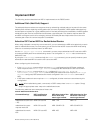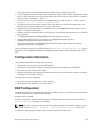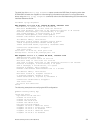
• High CPU utilization may be observed during an SNMP walk of a large BGP Loc-RIB.
• To avoid SNMP timeouts with a large-scale configuration (large number of BGP neighbors and a large
BGP Loc-RIB), Dell Networking recommends setting the timeout and retry count values to a relatively
higher number. For example, t = 60 or r = 5.
• To return all values on an snmpwalk for the f10BgpM2Peer sub-OID, use the -C c option, such as
snmpwalk -v 2c -C c -c public<IP_address><OID>.
• An SNMP walk may terminate pre-maturely if the index does not increment lexicographically. Dell
Networking recommends using options to ignore such errors.
• Multiple BPG process instances are not supported. Thus, the f10BgpM2PeerInstance field in various
tables is not used to locate a peer.
• Multiple instances of the same NLRI in the BGP RIB are not supported and are set to zero in the SNMP
query response.
• The f10BgpM2NlriIndex and f10BgpM2AdjRibsOutIndex fields are not used.
• Carrying MPLS labels in BGP is not supported. The f10BgpM2NlriOpaqueType and
f10BgpM2NlriOpaquePointer fields are set to zero.
• 4-byte ASN is supported. The f10BgpM2AsPath4byteEntry table contains 4-byte ASN-related
parameters based on the configuration.
Traps (notifications) specified in the BGP4 MIB draft <draft-ietf-idr-bgp4–mibv2–05.txt> are not
supported. Such traps (bgpM2Established and bgpM2BackwardTransition) are supported as part of RFC
1657.
Configuration Information
The software supports BGPv4 as well as the following:
• deterministic multi-exit discriminator (MED) (default)
• a path with a missing MED is treated as worst path and assigned an MED value of (0xffffffff)
• the community format follows RFC 1998
• delayed configuration (the software at system boot reads the entire configuration file prior to sending
messages to start BGP peer sessions)
The following are not yet supported:
• auto-summarization (the default is no auto-summary)
• synchronization (the default is no synchronization)
BGP Configuration
To enable the BGP process and begin exchanging information, assign an AS number and use commands
in ROUTER BGP mode to configure a BGP neighbor.
By default, BGP is disabled.
By default, the system compares the MED attribute on different paths from within the same AS (the bgp
always-compare-med command is not enabled).
NOTE: All newly configured neighbors and peer groups are disabled. To enable a neighbor or peer
group, enter the neighbor {ip-address | peer-group-name} no shutdown command.
The following table displays the default values for BGP in the Dell Networking OS.
Border Gateway Protocol IPv4 (BGPv4)
167


















